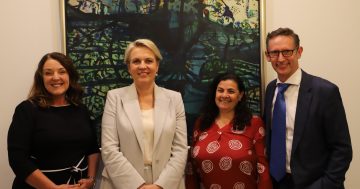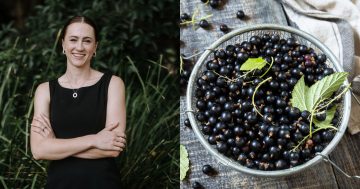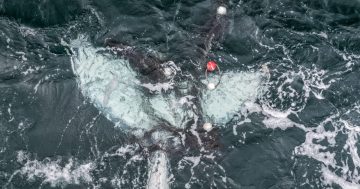
Dr Katharina Peters and Professor Karen Stockin at Massey University (NZ), conduct an external assessment of a common dolphin before collecting a liver sample to include in their study. Photo: UOW.
There’s no place to hide from toxic “forever chemicals”, with potential implications for fertility and our immune systems, researchers have found.
A new international study has upended long-held assumptions about the safety of the deep ocean, showing that whales and dolphins living far below the surface are carrying unprecedented levels of PFAS (per- and polyfluoroalkyl substances), a large group of human-made chemicals used in a wide range of products because they resist heat, stains, grease and water.
Also known as “forever chemicals”, PFAS are highly persistent and have long been accumulating in the environment and in living organisms, including humans.
The ground-breaking research, led by Te Kunenga ki Pūrehuroa Massey University with contributions from University of Wollongong Marine Vertebrate Ecology Lab research leader Dr Katharina Peters, is the first to assess PFAS contamination across such a wide range of marine mammals in the same region and timeframe.
It reveals that the deep sea — often imagined as a refuge from human impact — is no protection from industrial pollution.
“Whales and dolphins are considered indicator species, because they live long and reflect the state of their ecosystem,” she said.
“We expected that species feeding mainly in deep water, like sperm whales, would have lower PFAS contamination than coastal species like Hector’s dolphins which are closer to pollution sources.
“Our analyses show that this is not the case: there really seems to be no place to hide from PFAS.”
To understand the extent of exposure, researchers examined tissues from 127 whales and dolphins representing 16 species found in New Zealand waters. The sample included everything from coastal bottlenose dolphins to deep-diving sperm whales.
For eight species, including New Zealand’s endemic Hector’s dolphin and several beaked whale species, this marks the first PFAS assessment ever conducted.
Published in Science of the Total Environment, the study has alarming implications about the long-term health of marine species and, consequently, humans.
Animals high in the food chain, such as whales and dolphins, are bio-accumulators of everything in that food chain. So are humans.
“We eat the same fish they do, so in terms of bioaccumulation of PFAS, it stands to reason that they’d be similar to us,” Dr Peters said.
“PFAS has already been linked to hormonal disruption, potentially affecting fertility and causing immune suppression. It doesn’t bode well for our health.”
Aside from the direct impact on human health, it also has implications for the marine environment we depend on.
“We don’t know the threshold whales can deal with, and when their exposure will have an effect. These are species already facing challenges — they’re caught in nets, their food is dwindling, their habitat is degrading and they reproduce slowly. Now that interference with their immune, endocrine (hormonal) and reproductive functions is another hurdle to their survival.
“These are important species to our oceans, and if there are consequences to the population, they can’t recover quickly.”
PFAS are commonly found in non-stick cookware, stain and water-resistant fabrics such as carpets and clothing, food packaging, and certain personal care products. Other common sources include some cosmetics, firefighting foams and paints.
Consumers can look for labels such as “water-resistant,” “grease-resistant” or “non-stick” as indicators of their presence, but PFAS aren’t consistently declared on items.
“Legislation needs to be more stringent on what chemicals are OK to use in industry applications,” Dr Peters said.
“Also for Australia, I think it’s important to highlight the value of doing full examinations of whales and dolphins that strand, so we can take samples which can then be analysed as we did.
“This can be challenging, time-consuming and expensive, but it’s essential if we want to know what’s going on in our oceans.”
The trans-Tasman collaboration involved UOW, Massey University, Manaaki Whenua — Landcare Research, University of Auckland, UTS and the Australian Museum.
















